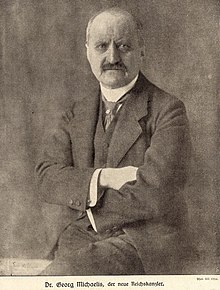Kreuznach Conference (August 9, 1917)
Additionally, the conference served as the primary meeting between the new Imperial Chancellor, Georg Michaelis, and the two main leaders of the German High Command, Erich Ludendorff[nb 2][1] and Paul von Hindenburg.
At this meeting, the military tried to impose the war aims they set for the conflict on the members of the civilian government, based on the minutes of the April 23, 1917 conference.
Additionally, he informed his German counterparts that the dual monarchy could not stay involved in the conflict, demonstrating his new vision for the alliance between Austria-Hungary and Germany.
[7] In response, the Germans vehemently opposed any peace[8] initiatives proposed by their Austro-Hungarian counterparts and instead doubled-down on their Eastern policy in the Baltic states, Poland, and Ukraine.
[9] Thus, German representatives sought to achieve their war objectives by promoting the emergence of separatist movements in Ukraine and the Baltic states, using the fiction of local support.
Ottokar Czernin attempted to advocate for the point of view of the dual monarchy in bilateral discussions, while publicly displaying complete agreement with German positions.
In the face of a growing power imbalance against the dual monarchy, Ottokar Czernin ensured the strength of the German-Austro-Hungarian alliance by denouncing any attempts to negotiate with the Allies as "treason".
Civilians preferred to return to pre-war trade practices, specifically implementing the most-favored-nation clause in Europe with priority given to German companies.
The annexations he advocated aimed to directly control the Lorraine and Polish steel basins, and create a protective glacis for these resource-rich mining regions.
Furthermore, the German government and military were strategizing to gain command over Ukraine's agricultural and mining resources, in addition to their northern expansion plans.
Two options were presented to the Polish representatives in the Reich: either the annexation of their territory under the new Reichsland[nb 5] or the establishment of formal independence through the creation of a German defensive glacis extending to the outskirts of Warsaw.
In compliance with the April-defined program, the Reich was designated to uphold an occupation force on Belgian territory for an extended duration as ensured by the peace treaties.
[18] The Dioscuri, the Chancellor, and the Secretary of State aimed to establish a political, military, commercial, and economic entity under the control of the Reich with a strong structure based on the quadruplice.
[10] To achieve their massive expansion goals, German leaders aimed to tightly control Belgium and its coastal areas without specifying the precise form of domination.
On the eastern side, conference attendees, both civilian and military, advocated for coordinated civilian-military action in support of all separatist movements in the Baltic regions and Ukraine.
Georg Michaelis suggested the formation of "freely elected" committees composed of individuals sympathetic to the central powers to organize "spontaneous" demonstrations by pressure groups.





